Business Strategy Report: Analysis of Sainsbury's Strategic Planning
VerifiedAdded on 2019/12/28
|8
|1991
|323
Report
AI Summary
This report delves into the intricacies of business strategy, using Sainsbury's as a case study. It examines the roles of mission, vision, objectives, and goals in informing strategic planning. The report explores factors crucial for formulating strategic plans, such as competitive direction, planning systems, and stakeholder considerations. It evaluates various techniques for developing strategic plans, including SWOT, PESTLE, Porter's Five Forces, and Ansoff's Matrix, highlighting their advantages and disadvantages. The analysis covers Sainsbury's core competencies, strategic architecture, and strategic control methods. The conclusion emphasizes the importance of a well-defined mission, vision, and objectives for effective strategy development and the application of different business models in strategic planning. This report is a valuable resource for understanding the practical application of business strategy within a real-world context.
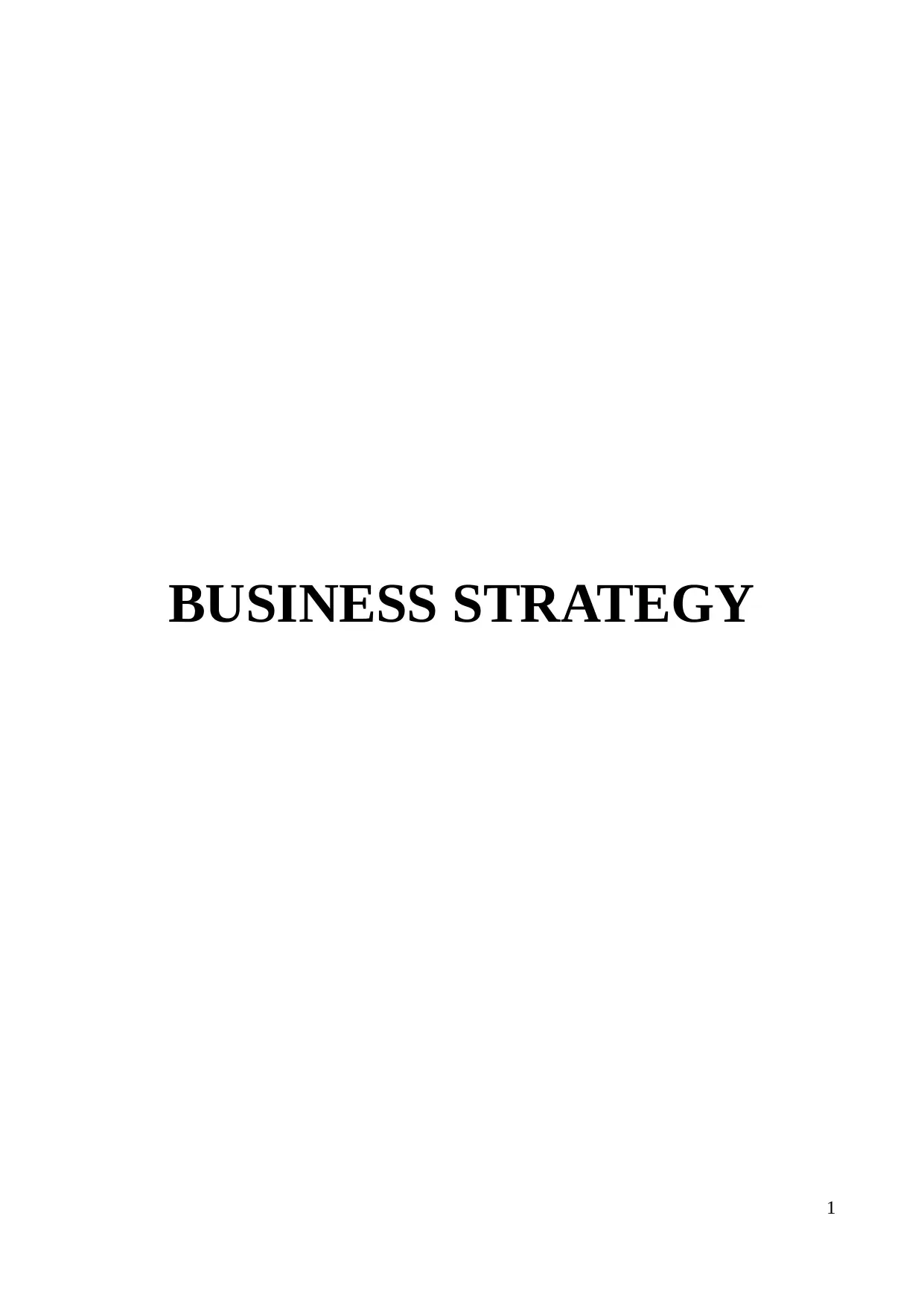
BUSINESS STRATEGY
1
1
Paraphrase This Document
Need a fresh take? Get an instant paraphrase of this document with our AI Paraphraser
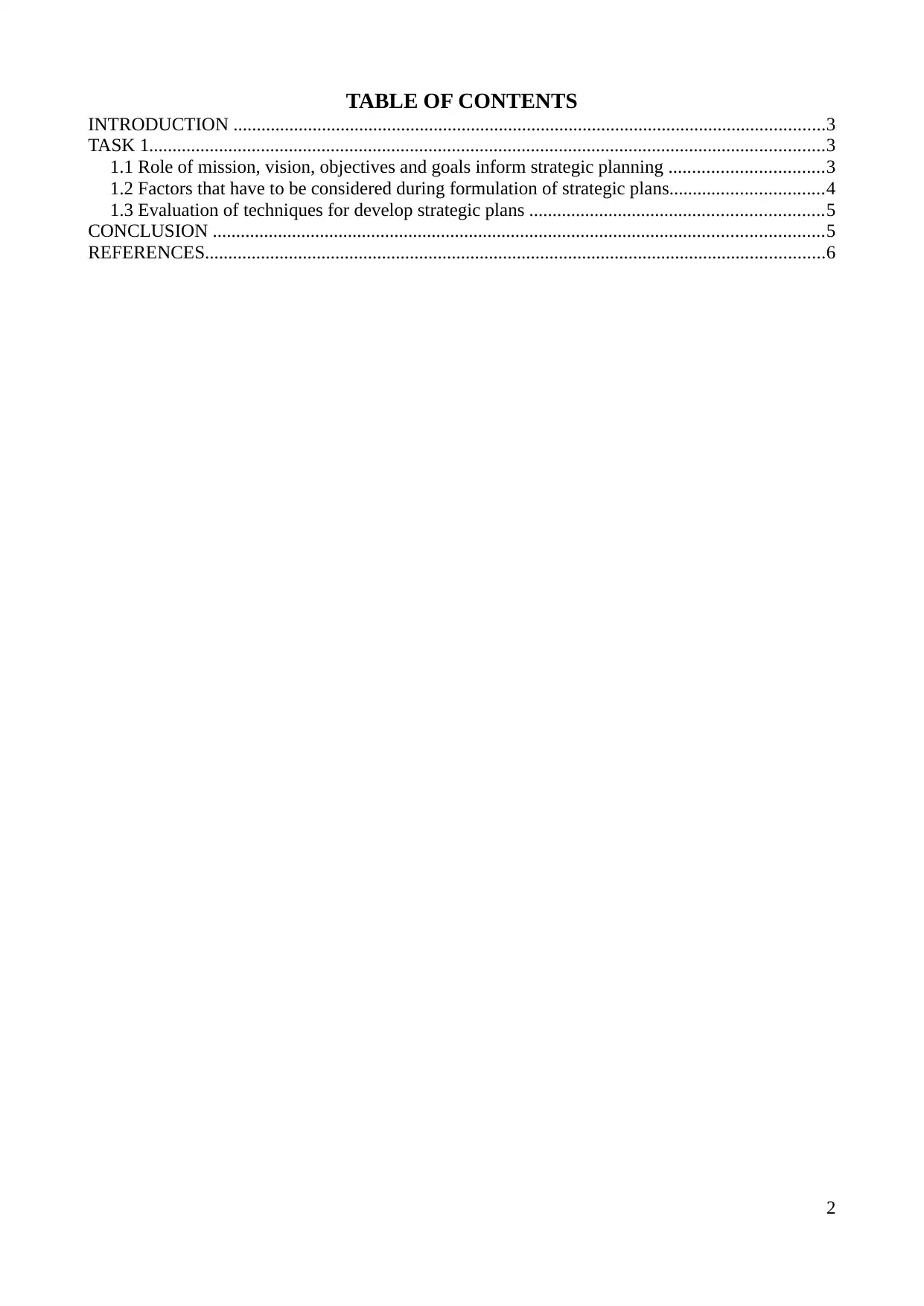
TABLE OF CONTENTS
INTRODUCTION ...............................................................................................................................3
TASK 1.................................................................................................................................................3
1.1 Role of mission, vision, objectives and goals inform strategic planning .................................3
1.2 Factors that have to be considered during formulation of strategic plans.................................4
1.3 Evaluation of techniques for develop strategic plans ...............................................................5
CONCLUSION ...................................................................................................................................5
REFERENCES.....................................................................................................................................6
2
INTRODUCTION ...............................................................................................................................3
TASK 1.................................................................................................................................................3
1.1 Role of mission, vision, objectives and goals inform strategic planning .................................3
1.2 Factors that have to be considered during formulation of strategic plans.................................4
1.3 Evaluation of techniques for develop strategic plans ...............................................................5
CONCLUSION ...................................................................................................................................5
REFERENCES.....................................................................................................................................6
2
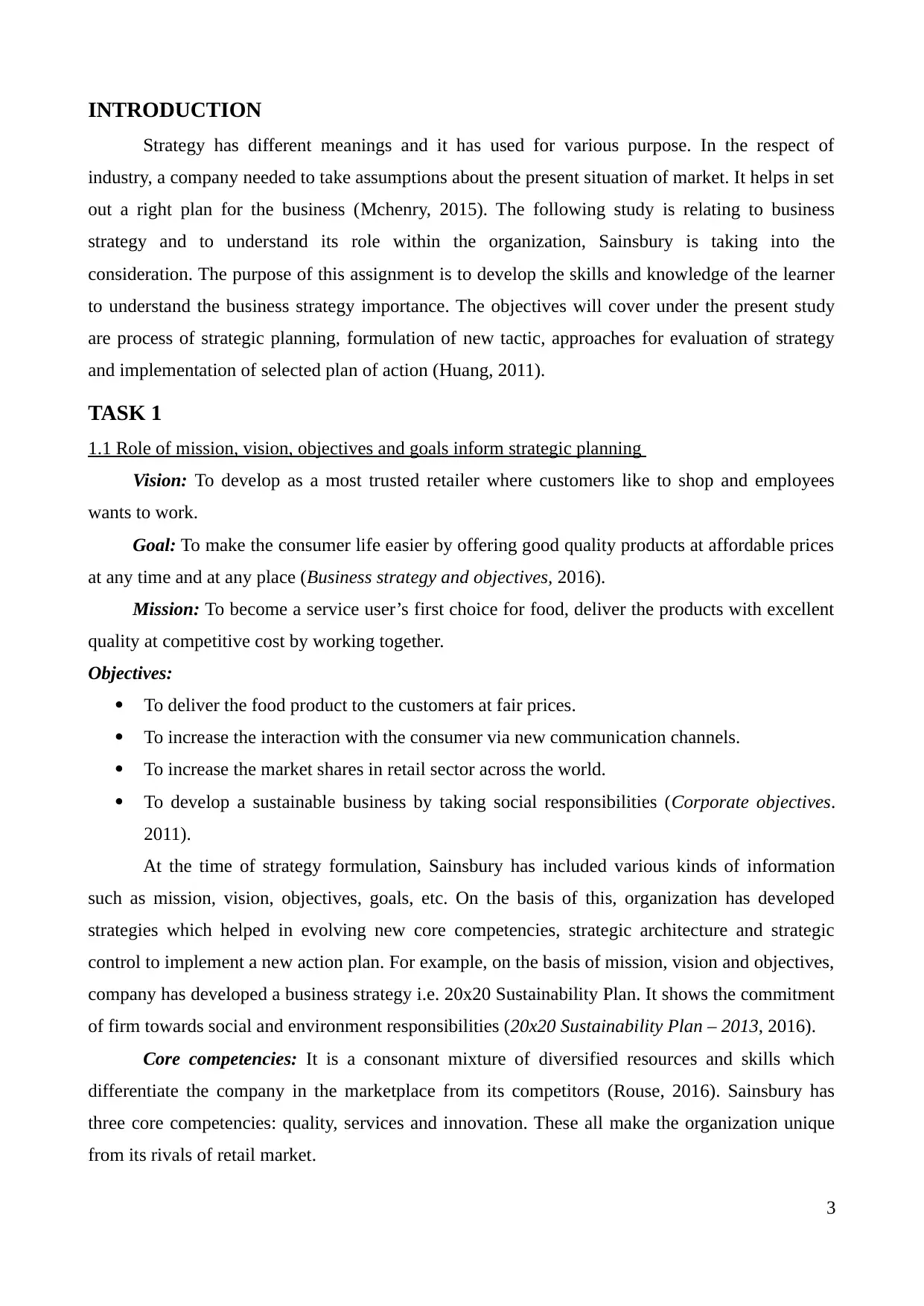
INTRODUCTION
Strategy has different meanings and it has used for various purpose. In the respect of
industry, a company needed to take assumptions about the present situation of market. It helps in set
out a right plan for the business (Mchenry, 2015). The following study is relating to business
strategy and to understand its role within the organization, Sainsbury is taking into the
consideration. The purpose of this assignment is to develop the skills and knowledge of the learner
to understand the business strategy importance. The objectives will cover under the present study
are process of strategic planning, formulation of new tactic, approaches for evaluation of strategy
and implementation of selected plan of action (Huang, 2011).
TASK 1
1.1 Role of mission, vision, objectives and goals inform strategic planning
Vision: To develop as a most trusted retailer where customers like to shop and employees
wants to work.
Goal: To make the consumer life easier by offering good quality products at affordable prices
at any time and at any place (Business strategy and objectives, 2016).
Mission: To become a service user’s first choice for food, deliver the products with excellent
quality at competitive cost by working together.
Objectives:
To deliver the food product to the customers at fair prices.
To increase the interaction with the consumer via new communication channels.
To increase the market shares in retail sector across the world.
To develop a sustainable business by taking social responsibilities (Corporate objectives.
2011).
At the time of strategy formulation, Sainsbury has included various kinds of information
such as mission, vision, objectives, goals, etc. On the basis of this, organization has developed
strategies which helped in evolving new core competencies, strategic architecture and strategic
control to implement a new action plan. For example, on the basis of mission, vision and objectives,
company has developed a business strategy i.e. 20x20 Sustainability Plan. It shows the commitment
of firm towards social and environment responsibilities (20x20 Sustainability Plan – 2013, 2016).
Core competencies: It is a consonant mixture of diversified resources and skills which
differentiate the company in the marketplace from its competitors (Rouse, 2016). Sainsbury has
three core competencies: quality, services and innovation. These all make the organization unique
from its rivals of retail market.
3
Strategy has different meanings and it has used for various purpose. In the respect of
industry, a company needed to take assumptions about the present situation of market. It helps in set
out a right plan for the business (Mchenry, 2015). The following study is relating to business
strategy and to understand its role within the organization, Sainsbury is taking into the
consideration. The purpose of this assignment is to develop the skills and knowledge of the learner
to understand the business strategy importance. The objectives will cover under the present study
are process of strategic planning, formulation of new tactic, approaches for evaluation of strategy
and implementation of selected plan of action (Huang, 2011).
TASK 1
1.1 Role of mission, vision, objectives and goals inform strategic planning
Vision: To develop as a most trusted retailer where customers like to shop and employees
wants to work.
Goal: To make the consumer life easier by offering good quality products at affordable prices
at any time and at any place (Business strategy and objectives, 2016).
Mission: To become a service user’s first choice for food, deliver the products with excellent
quality at competitive cost by working together.
Objectives:
To deliver the food product to the customers at fair prices.
To increase the interaction with the consumer via new communication channels.
To increase the market shares in retail sector across the world.
To develop a sustainable business by taking social responsibilities (Corporate objectives.
2011).
At the time of strategy formulation, Sainsbury has included various kinds of information
such as mission, vision, objectives, goals, etc. On the basis of this, organization has developed
strategies which helped in evolving new core competencies, strategic architecture and strategic
control to implement a new action plan. For example, on the basis of mission, vision and objectives,
company has developed a business strategy i.e. 20x20 Sustainability Plan. It shows the commitment
of firm towards social and environment responsibilities (20x20 Sustainability Plan – 2013, 2016).
Core competencies: It is a consonant mixture of diversified resources and skills which
differentiate the company in the marketplace from its competitors (Rouse, 2016). Sainsbury has
three core competencies: quality, services and innovation. These all make the organization unique
from its rivals of retail market.
3
⊘ This is a preview!⊘
Do you want full access?
Subscribe today to unlock all pages.

Trusted by 1+ million students worldwide
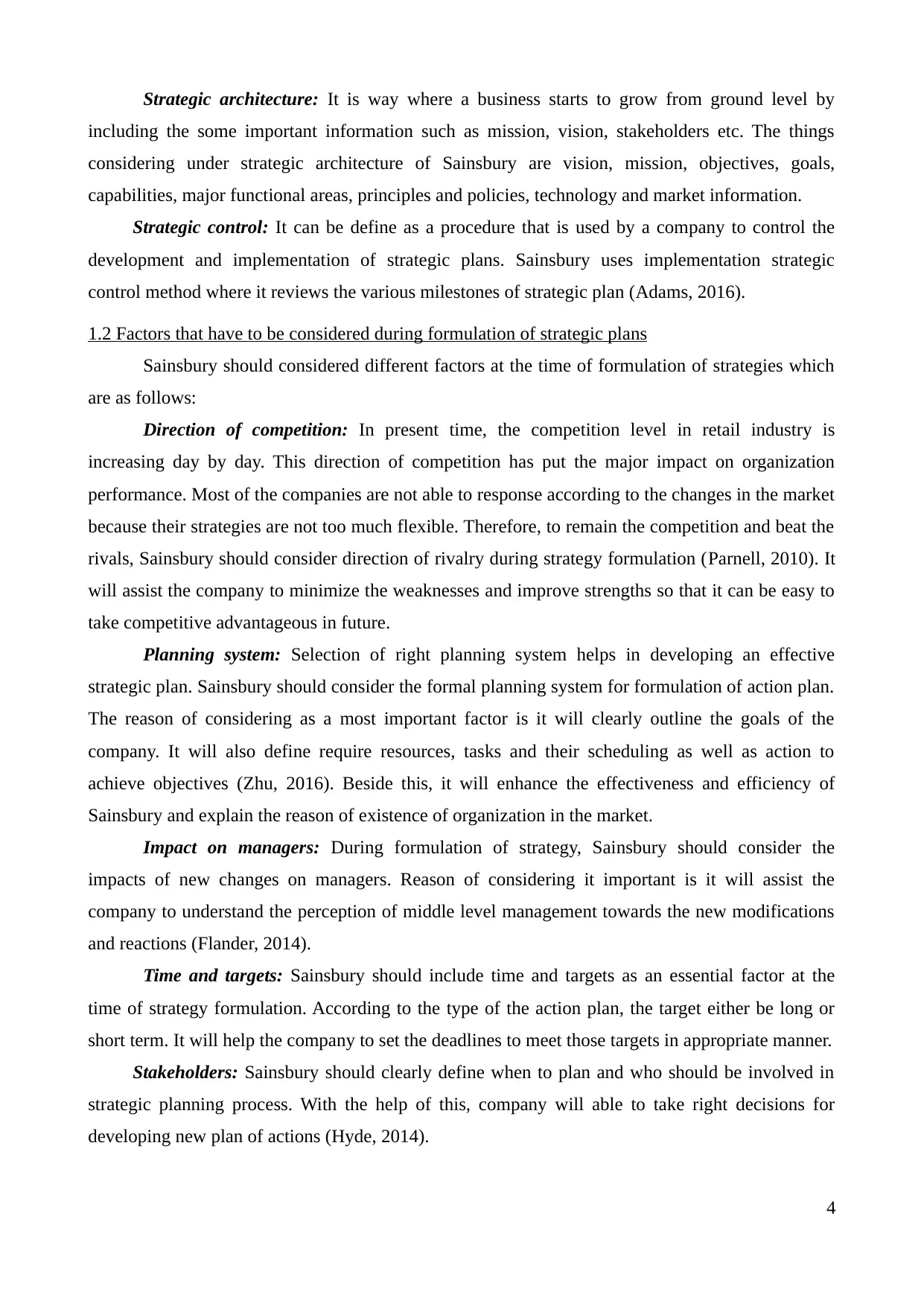
Strategic architecture: It is way where a business starts to grow from ground level by
including the some important information such as mission, vision, stakeholders etc. The things
considering under strategic architecture of Sainsbury are vision, mission, objectives, goals,
capabilities, major functional areas, principles and policies, technology and market information.
Strategic control: It can be define as a procedure that is used by a company to control the
development and implementation of strategic plans. Sainsbury uses implementation strategic
control method where it reviews the various milestones of strategic plan (Adams, 2016).
1.2 Factors that have to be considered during formulation of strategic plans
Sainsbury should considered different factors at the time of formulation of strategies which
are as follows:
Direction of competition: In present time, the competition level in retail industry is
increasing day by day. This direction of competition has put the major impact on organization
performance. Most of the companies are not able to response according to the changes in the market
because their strategies are not too much flexible. Therefore, to remain the competition and beat the
rivals, Sainsbury should consider direction of rivalry during strategy formulation (Parnell, 2010). It
will assist the company to minimize the weaknesses and improve strengths so that it can be easy to
take competitive advantageous in future.
Planning system: Selection of right planning system helps in developing an effective
strategic plan. Sainsbury should consider the formal planning system for formulation of action plan.
The reason of considering as a most important factor is it will clearly outline the goals of the
company. It will also define require resources, tasks and their scheduling as well as action to
achieve objectives (Zhu, 2016). Beside this, it will enhance the effectiveness and efficiency of
Sainsbury and explain the reason of existence of organization in the market.
Impact on managers: During formulation of strategy, Sainsbury should consider the
impacts of new changes on managers. Reason of considering it important is it will assist the
company to understand the perception of middle level management towards the new modifications
and reactions (Flander, 2014).
Time and targets: Sainsbury should include time and targets as an essential factor at the
time of strategy formulation. According to the type of the action plan, the target either be long or
short term. It will help the company to set the deadlines to meet those targets in appropriate manner.
Stakeholders: Sainsbury should clearly define when to plan and who should be involved in
strategic planning process. With the help of this, company will able to take right decisions for
developing new plan of actions (Hyde, 2014).
4
including the some important information such as mission, vision, stakeholders etc. The things
considering under strategic architecture of Sainsbury are vision, mission, objectives, goals,
capabilities, major functional areas, principles and policies, technology and market information.
Strategic control: It can be define as a procedure that is used by a company to control the
development and implementation of strategic plans. Sainsbury uses implementation strategic
control method where it reviews the various milestones of strategic plan (Adams, 2016).
1.2 Factors that have to be considered during formulation of strategic plans
Sainsbury should considered different factors at the time of formulation of strategies which
are as follows:
Direction of competition: In present time, the competition level in retail industry is
increasing day by day. This direction of competition has put the major impact on organization
performance. Most of the companies are not able to response according to the changes in the market
because their strategies are not too much flexible. Therefore, to remain the competition and beat the
rivals, Sainsbury should consider direction of rivalry during strategy formulation (Parnell, 2010). It
will assist the company to minimize the weaknesses and improve strengths so that it can be easy to
take competitive advantageous in future.
Planning system: Selection of right planning system helps in developing an effective
strategic plan. Sainsbury should consider the formal planning system for formulation of action plan.
The reason of considering as a most important factor is it will clearly outline the goals of the
company. It will also define require resources, tasks and their scheduling as well as action to
achieve objectives (Zhu, 2016). Beside this, it will enhance the effectiveness and efficiency of
Sainsbury and explain the reason of existence of organization in the market.
Impact on managers: During formulation of strategy, Sainsbury should consider the
impacts of new changes on managers. Reason of considering it important is it will assist the
company to understand the perception of middle level management towards the new modifications
and reactions (Flander, 2014).
Time and targets: Sainsbury should include time and targets as an essential factor at the
time of strategy formulation. According to the type of the action plan, the target either be long or
short term. It will help the company to set the deadlines to meet those targets in appropriate manner.
Stakeholders: Sainsbury should clearly define when to plan and who should be involved in
strategic planning process. With the help of this, company will able to take right decisions for
developing new plan of actions (Hyde, 2014).
4
Paraphrase This Document
Need a fresh take? Get an instant paraphrase of this document with our AI Paraphraser
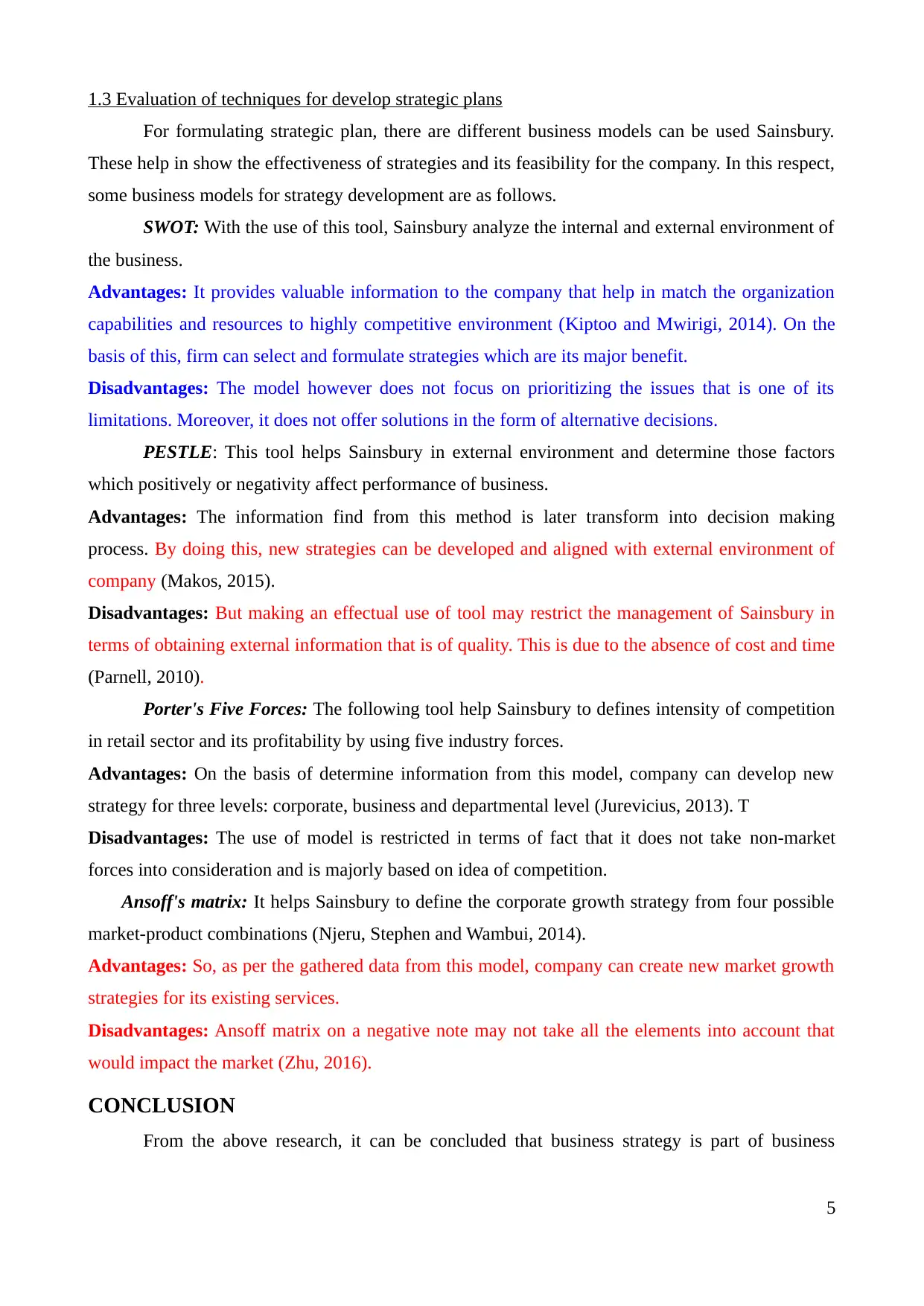
1.3 Evaluation of techniques for develop strategic plans
For formulating strategic plan, there are different business models can be used Sainsbury.
These help in show the effectiveness of strategies and its feasibility for the company. In this respect,
some business models for strategy development are as follows.
SWOT: With the use of this tool, Sainsbury analyze the internal and external environment of
the business.
Advantages: It provides valuable information to the company that help in match the organization
capabilities and resources to highly competitive environment (Kiptoo and Mwirigi, 2014). On the
basis of this, firm can select and formulate strategies which are its major benefit.
Disadvantages: The model however does not focus on prioritizing the issues that is one of its
limitations. Moreover, it does not offer solutions in the form of alternative decisions.
PESTLE: This tool helps Sainsbury in external environment and determine those factors
which positively or negativity affect performance of business.
Advantages: The information find from this method is later transform into decision making
process. By doing this, new strategies can be developed and aligned with external environment of
company (Makos, 2015).
Disadvantages: But making an effectual use of tool may restrict the management of Sainsbury in
terms of obtaining external information that is of quality. This is due to the absence of cost and time
(Parnell, 2010).
Porter's Five Forces: The following tool help Sainsbury to defines intensity of competition
in retail sector and its profitability by using five industry forces.
Advantages: On the basis of determine information from this model, company can develop new
strategy for three levels: corporate, business and departmental level (Jurevicius, 2013). T
Disadvantages: The use of model is restricted in terms of fact that it does not take non-market
forces into consideration and is majorly based on idea of competition.
Ansoff's matrix: It helps Sainsbury to define the corporate growth strategy from four possible
market-product combinations (Njeru, Stephen and Wambui, 2014).
Advantages: So, as per the gathered data from this model, company can create new market growth
strategies for its existing services.
Disadvantages: Ansoff matrix on a negative note may not take all the elements into account that
would impact the market (Zhu, 2016).
CONCLUSION
From the above research, it can be concluded that business strategy is part of business
5
For formulating strategic plan, there are different business models can be used Sainsbury.
These help in show the effectiveness of strategies and its feasibility for the company. In this respect,
some business models for strategy development are as follows.
SWOT: With the use of this tool, Sainsbury analyze the internal and external environment of
the business.
Advantages: It provides valuable information to the company that help in match the organization
capabilities and resources to highly competitive environment (Kiptoo and Mwirigi, 2014). On the
basis of this, firm can select and formulate strategies which are its major benefit.
Disadvantages: The model however does not focus on prioritizing the issues that is one of its
limitations. Moreover, it does not offer solutions in the form of alternative decisions.
PESTLE: This tool helps Sainsbury in external environment and determine those factors
which positively or negativity affect performance of business.
Advantages: The information find from this method is later transform into decision making
process. By doing this, new strategies can be developed and aligned with external environment of
company (Makos, 2015).
Disadvantages: But making an effectual use of tool may restrict the management of Sainsbury in
terms of obtaining external information that is of quality. This is due to the absence of cost and time
(Parnell, 2010).
Porter's Five Forces: The following tool help Sainsbury to defines intensity of competition
in retail sector and its profitability by using five industry forces.
Advantages: On the basis of determine information from this model, company can develop new
strategy for three levels: corporate, business and departmental level (Jurevicius, 2013). T
Disadvantages: The use of model is restricted in terms of fact that it does not take non-market
forces into consideration and is majorly based on idea of competition.
Ansoff's matrix: It helps Sainsbury to define the corporate growth strategy from four possible
market-product combinations (Njeru, Stephen and Wambui, 2014).
Advantages: So, as per the gathered data from this model, company can create new market growth
strategies for its existing services.
Disadvantages: Ansoff matrix on a negative note may not take all the elements into account that
would impact the market (Zhu, 2016).
CONCLUSION
From the above research, it can be concluded that business strategy is part of business
5
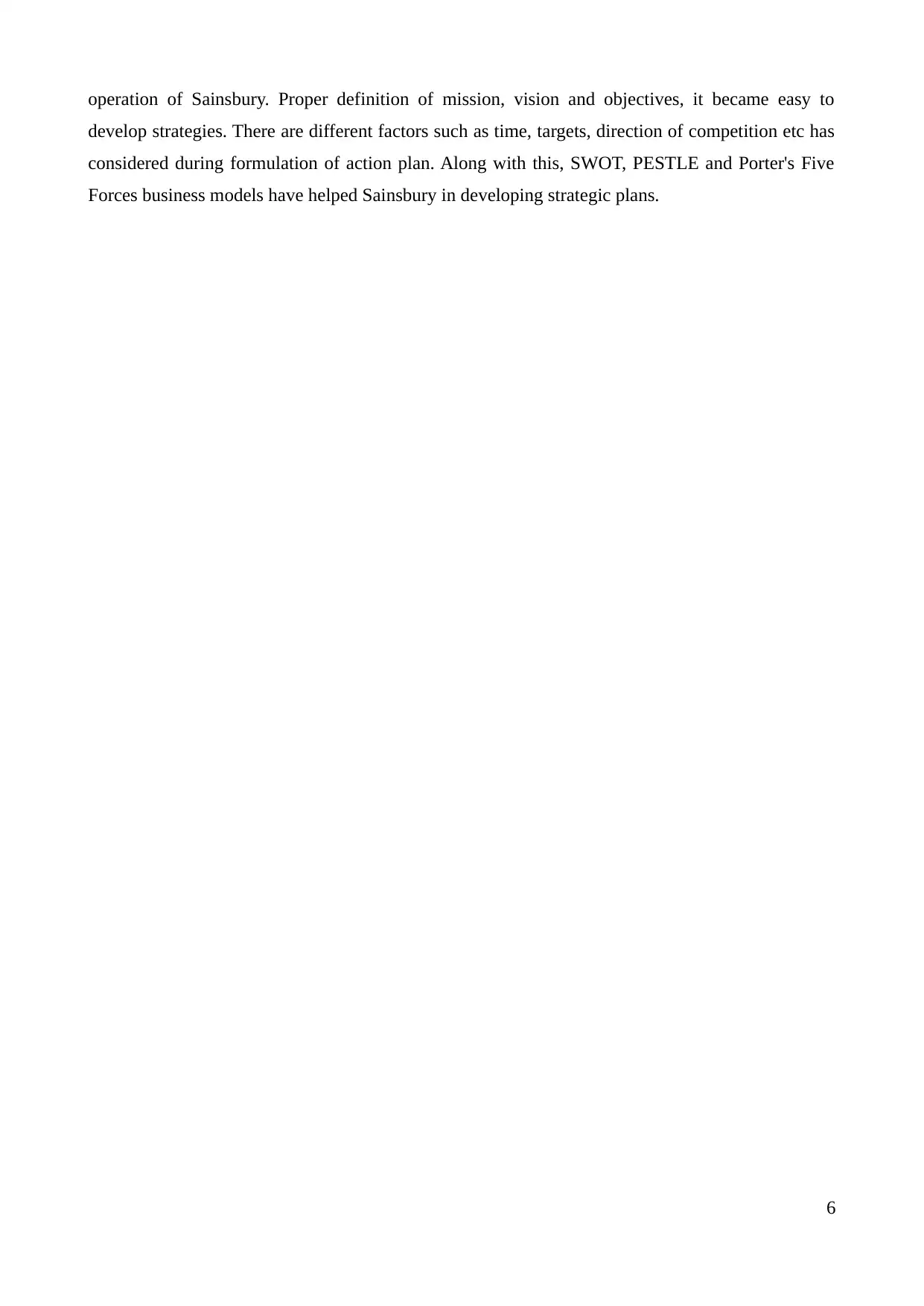
operation of Sainsbury. Proper definition of mission, vision and objectives, it became easy to
develop strategies. There are different factors such as time, targets, direction of competition etc has
considered during formulation of action plan. Along with this, SWOT, PESTLE and Porter's Five
Forces business models have helped Sainsbury in developing strategic plans.
6
develop strategies. There are different factors such as time, targets, direction of competition etc has
considered during formulation of action plan. Along with this, SWOT, PESTLE and Porter's Five
Forces business models have helped Sainsbury in developing strategic plans.
6
⊘ This is a preview!⊘
Do you want full access?
Subscribe today to unlock all pages.

Trusted by 1+ million students worldwide
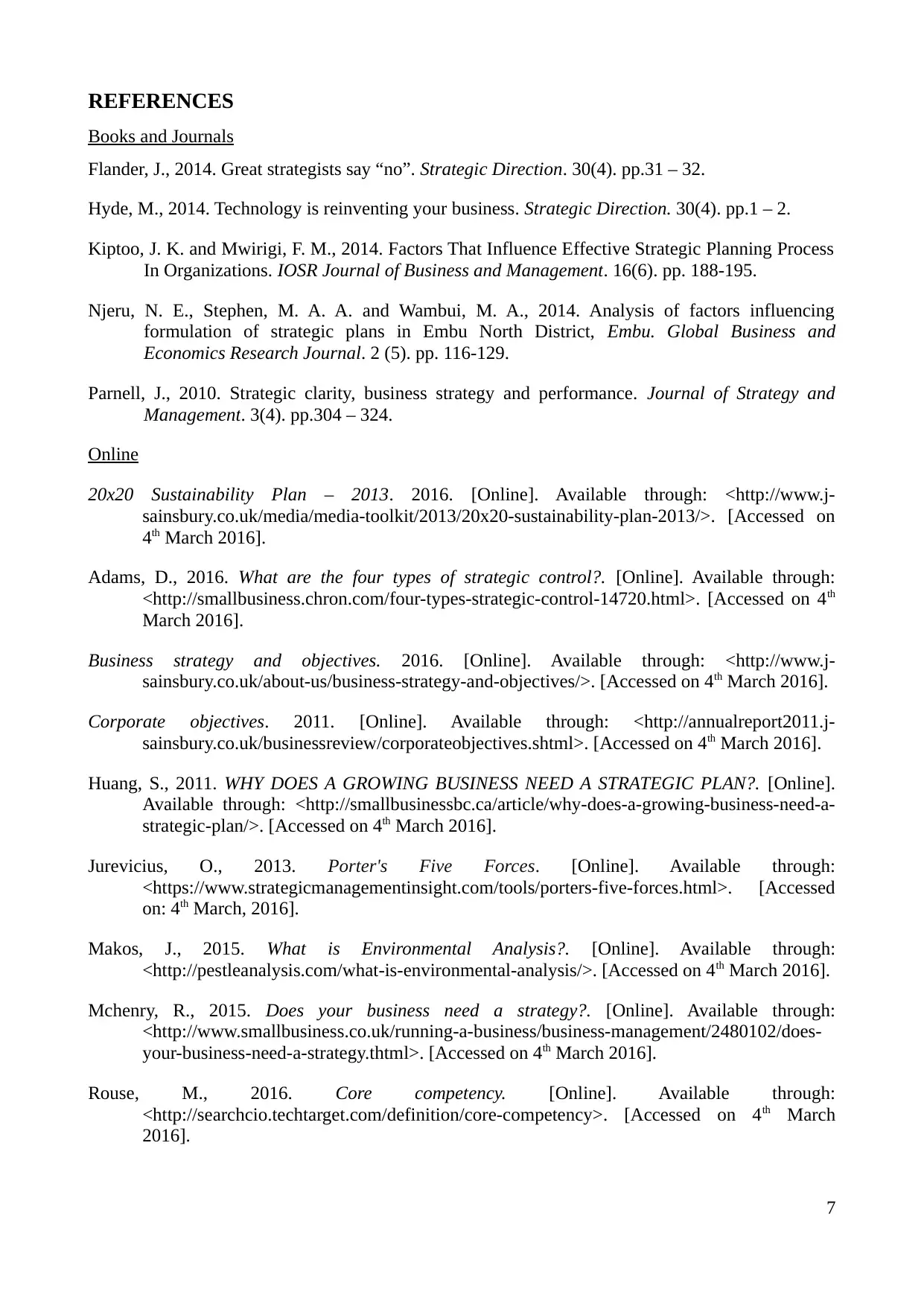
REFERENCES
Books and Journals
Flander, J., 2014. Great strategists say “no”. Strategic Direction. 30(4). pp.31 – 32.
Hyde, M., 2014. Technology is reinventing your business. Strategic Direction. 30(4). pp.1 – 2.
Kiptoo, J. K. and Mwirigi, F. M., 2014. Factors That Influence Effective Strategic Planning Process
In Organizations. IOSR Journal of Business and Management. 16(6). pp. 188-195.
Njeru, N. E., Stephen, M. A. A. and Wambui, M. A., 2014. Analysis of factors influencing
formulation of strategic plans in Embu North District, Embu. Global Business and
Economics Research Journal. 2 (5). pp. 116-129.
Parnell, J., 2010. Strategic clarity, business strategy and performance. Journal of Strategy and
Management. 3(4). pp.304 – 324.
Online
20x20 Sustainability Plan – 2013. 2016. [Online]. Available through: <http://www.j-
sainsbury.co.uk/media/media-toolkit/2013/20x20-sustainability-plan-2013/>. [Accessed on
4th March 2016].
Adams, D., 2016. What are the four types of strategic control?. [Online]. Available through:
<http://smallbusiness.chron.com/four-types-strategic-control-14720.html>. [Accessed on 4th
March 2016].
Business strategy and objectives. 2016. [Online]. Available through: <http://www.j-
sainsbury.co.uk/about-us/business-strategy-and-objectives/>. [Accessed on 4th March 2016].
Corporate objectives. 2011. [Online]. Available through: <http://annualreport2011.j-
sainsbury.co.uk/businessreview/corporateobjectives.shtml>. [Accessed on 4th March 2016].
Huang, S., 2011. WHY DOES A GROWING BUSINESS NEED A STRATEGIC PLAN?. [Online].
Available through: <http://smallbusinessbc.ca/article/why-does-a-growing-business-need-a-
strategic-plan/>. [Accessed on 4th March 2016].
Jurevicius, O., 2013. Porter's Five Forces. [Online]. Available through:
<https://www.strategicmanagementinsight.com/tools/porters-five-forces.html>. [Accessed
on: 4th March, 2016].
Makos, J., 2015. What is Environmental Analysis?. [Online]. Available through:
<http://pestleanalysis.com/what-is-environmental-analysis/>. [Accessed on 4th March 2016].
Mchenry, R., 2015. Does your business need a strategy?. [Online]. Available through:
<http://www.smallbusiness.co.uk/running-a-business/business-management/2480102/does-
your-business-need-a-strategy.thtml>. [Accessed on 4th March 2016].
Rouse, M., 2016. Core competency. [Online]. Available through:
<http://searchcio.techtarget.com/definition/core-competency>. [Accessed on 4th March
2016].
7
Books and Journals
Flander, J., 2014. Great strategists say “no”. Strategic Direction. 30(4). pp.31 – 32.
Hyde, M., 2014. Technology is reinventing your business. Strategic Direction. 30(4). pp.1 – 2.
Kiptoo, J. K. and Mwirigi, F. M., 2014. Factors That Influence Effective Strategic Planning Process
In Organizations. IOSR Journal of Business and Management. 16(6). pp. 188-195.
Njeru, N. E., Stephen, M. A. A. and Wambui, M. A., 2014. Analysis of factors influencing
formulation of strategic plans in Embu North District, Embu. Global Business and
Economics Research Journal. 2 (5). pp. 116-129.
Parnell, J., 2010. Strategic clarity, business strategy and performance. Journal of Strategy and
Management. 3(4). pp.304 – 324.
Online
20x20 Sustainability Plan – 2013. 2016. [Online]. Available through: <http://www.j-
sainsbury.co.uk/media/media-toolkit/2013/20x20-sustainability-plan-2013/>. [Accessed on
4th March 2016].
Adams, D., 2016. What are the four types of strategic control?. [Online]. Available through:
<http://smallbusiness.chron.com/four-types-strategic-control-14720.html>. [Accessed on 4th
March 2016].
Business strategy and objectives. 2016. [Online]. Available through: <http://www.j-
sainsbury.co.uk/about-us/business-strategy-and-objectives/>. [Accessed on 4th March 2016].
Corporate objectives. 2011. [Online]. Available through: <http://annualreport2011.j-
sainsbury.co.uk/businessreview/corporateobjectives.shtml>. [Accessed on 4th March 2016].
Huang, S., 2011. WHY DOES A GROWING BUSINESS NEED A STRATEGIC PLAN?. [Online].
Available through: <http://smallbusinessbc.ca/article/why-does-a-growing-business-need-a-
strategic-plan/>. [Accessed on 4th March 2016].
Jurevicius, O., 2013. Porter's Five Forces. [Online]. Available through:
<https://www.strategicmanagementinsight.com/tools/porters-five-forces.html>. [Accessed
on: 4th March, 2016].
Makos, J., 2015. What is Environmental Analysis?. [Online]. Available through:
<http://pestleanalysis.com/what-is-environmental-analysis/>. [Accessed on 4th March 2016].
Mchenry, R., 2015. Does your business need a strategy?. [Online]. Available through:
<http://www.smallbusiness.co.uk/running-a-business/business-management/2480102/does-
your-business-need-a-strategy.thtml>. [Accessed on 4th March 2016].
Rouse, M., 2016. Core competency. [Online]. Available through:
<http://searchcio.techtarget.com/definition/core-competency>. [Accessed on 4th March
2016].
7
Paraphrase This Document
Need a fresh take? Get an instant paraphrase of this document with our AI Paraphraser
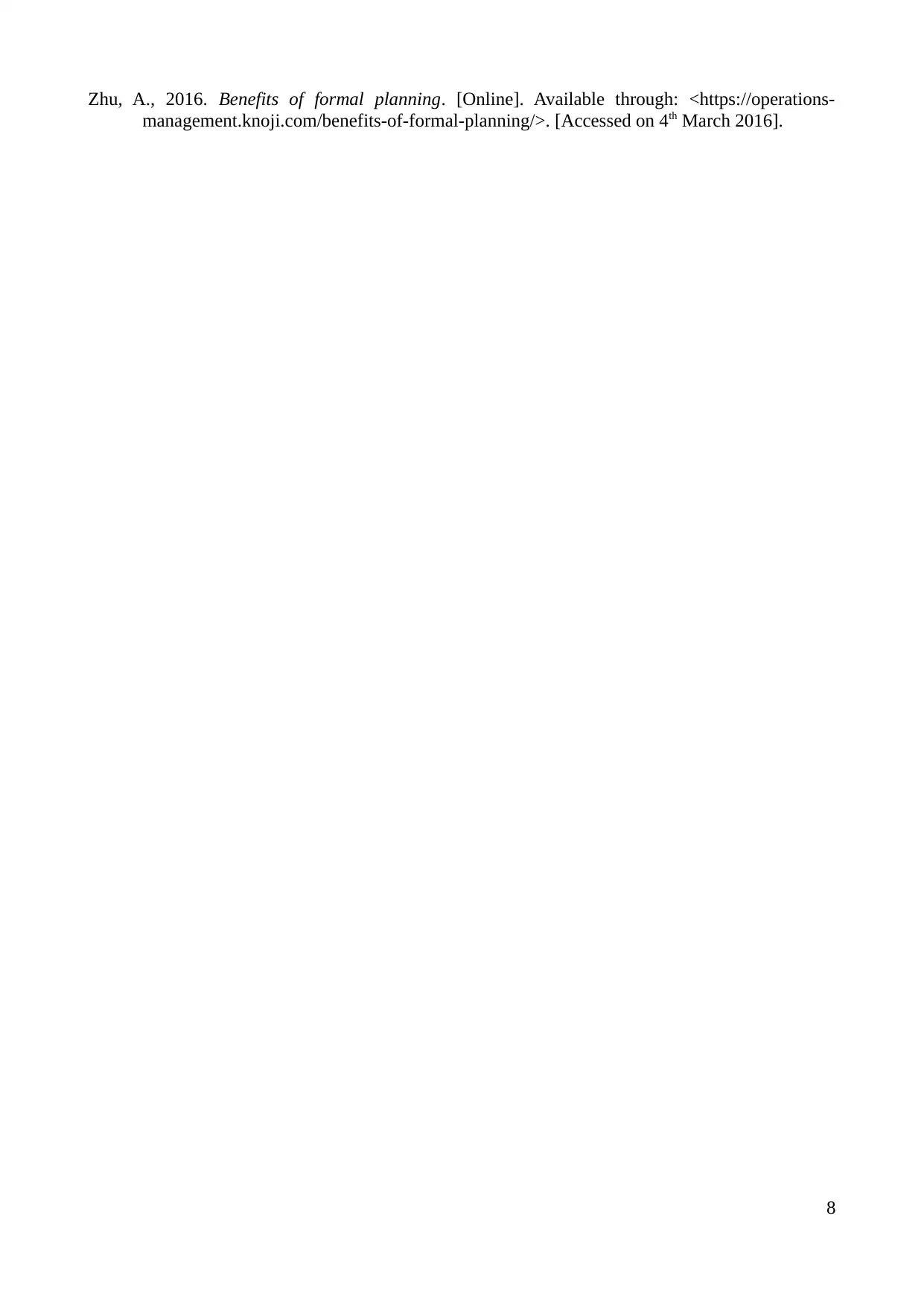
Zhu, A., 2016. Benefits of formal planning. [Online]. Available through: <https://operations-
management.knoji.com/benefits-of-formal-planning/>. [Accessed on 4th March 2016].
8
management.knoji.com/benefits-of-formal-planning/>. [Accessed on 4th March 2016].
8
1 out of 8
Related Documents
Your All-in-One AI-Powered Toolkit for Academic Success.
+13062052269
info@desklib.com
Available 24*7 on WhatsApp / Email
![[object Object]](/_next/static/media/star-bottom.7253800d.svg)
Unlock your academic potential
Copyright © 2020–2025 A2Z Services. All Rights Reserved. Developed and managed by ZUCOL.





